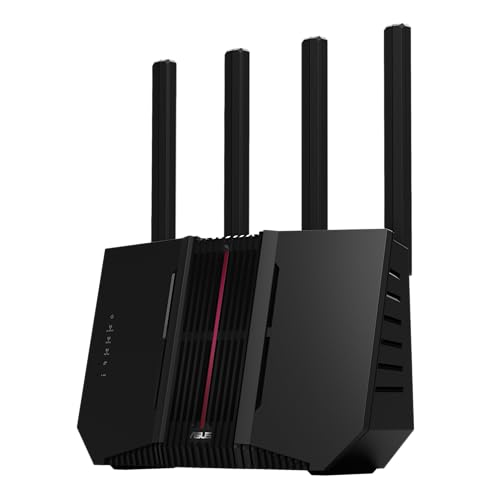Best Wi-Fi 7 routers for speed & stability
Affiliate disclosure: This post contains affiliate links. As an Amazon Associate, I earn from qualifying purchases.
How I researched
-
I compared official spec sheets for radios (tri/quad-band), BE ratings, 320 MHz support, and MLO.
-
I prioritized models with multi-gig ports (10 GbE, 2.5 GbE) and easy app setup.
-
I cross-checked hands-on reviews to gauge range, stability, and real-world throughput.
-
I verified current availability on Amazon listings (no prices shown below).
Top picks
1. TP-Link Deco BE95 — Best for whole-home multi-gig coverage (mesh)
A quad-band BE33000 system with two 6 GHz radios, 320 MHz channels, MLO, and 10 GbE for a true multi-gig backbone. If you want blanket coverage across big homes with lots of devices, this is the safe, fast pick.
- BE33000 Quad-Band Wi-Fi 7 Mesh: Experience unprecedented speeds with 11520 Mbps on 6GHz Band 1, 11520 Mbps on 6GHz Band 2, 8640 Mbps on 5GHz Band, and 1148 Mbps on 2.4 GHz Band
- Huge Leap in Coverage: Cover up to a colossal 7,800 Sq.Ft. with groundbreaking Wi-Fi 7 technology and make dead zones and buffering a thing of the past
- Game-Changing Connectivity: Connect over 200 devices on the mesh network without dragging down performance. Connect even more with 4 ethernet ports (2 X 10G Port, 2 X 2.5G Ports), providing incredibly advanced wired connections for devices like gaming console, 8K TV and more
Pros
-
Quad-band with dual 6 GHz for cleaner backhaul + client traffic
-
320 MHz + MLO for lower latency and higher peak speeds
-
10 GbE support for multi-gig WAN/LAN
-
Scales easily to very large homes
Cons
-
Large nodes and premium price
-
Advanced security/parental features may require a subscription
Who should skip -
Overkill for small apartments or sub-gigabit internet—consider a single high-end router below.
Affiliate disclosure: This post contains affiliate links. As an Amazon Associate, I earn from qualifying purchases.
2. Amazon eero Max 7 — Best for effortless setup & smart homes (mesh)
Tri-band Wi-Fi 7 with two 10 GbE and two 2.5 GbE ports, plus eero’s rock-solid roaming. It doubles as a smart-home hub (Matter/Thread/Zigbee), making it the easiest multi-gig upgrade for busy households.
- THE SPEED OF EERO MAX 7 - With two 10 Gigabit Ethernet ports, you can enjoy wired speeds up to 9.4 Gbps, wireless speeds up to 4.3 Gbps, and multi-gigabit backhaul speeds—making your network seriously fast.
- THE POWER OF WI-FI 7 TECHNOLOGY - Wi-Fi 7 technology can provide more than twice the speed of Wi-Fi 6, so you can enjoy greater capacity, less latency, and more efficiency on your network.
- OUR SOFTWARE MAKES ALL THE DIFFERENCE - Our patented TrueMesh software, combined with TrueRoam and TrueChannel, proactively keeps you connected to the optimal and most reliable wifi connection possible.
Pros
-
Dead-simple app and reliable whole-home roaming
-
Multi-gig friendly: dual 10 GbE + dual 2.5 GbE
-
Built-in smart-home hub support
Cons
-
Fewer advanced controls than ASUS/TP-Link
-
Some security features sit behind paid tiers
Who should skip -
Power users who want deep QoS/VPN/file-sharing should look at ASUS below.
3. ASUS RT-BE96U — Best single-router for power users & gamers
A BE19000 tri-band tower with dual 10 GbE, 320 MHz channels, 4096-QAM, AiMesh expandability, and robust firmware (QoS, VPN, more). A stellar “one-box” for smaller spaces that still want low-latency 6 GHz and lots of control.
- Beyond-fast WiFi 7 (802.11be) - New 320MHz channels in the 6 GHz band and 4096-QAM significantly increase network capacity and throughput, with speeds of up to 9700 Mbps
- Multi-link Operation - Link to multiple bands at the same time to ensure stable internet connections and efficient data transfers
- Versatile WAN configuration options - Establish always-on internet through AI WAN detection and a convenient USB port ready for 4G LTE and 5G Mobile tethering.
Pros
-
Dual 10 GbE and rich firmware features
-
320 MHz + 4K-QAM for peak Wi-Fi 7 speeds
-
AiMesh lets you add nodes later if needed
Cons
-
Big footprint and premium price
-
Single-router coverage may trail mesh in tricky floorplans
Who should skip -
Huge, multi-story homes should jump straight to mesh (Deco/eero).
4. NETGEAR Nighthawk RS700S — Best long-range stand-alone
Netgear’s flagship BE19000 router focuses on range and stability for homes that prefer one powerful tower. You get a 10 GbE internet port, modern Wi-Fi 7 features (including MLO/320 MHz), and an easy app.
- The most powerful Nighthawk router ever. Unrivaled WiFi 7 speeds up to 19Gbps for real-time gaming, 4K/8K streaming, UHD video conferencing, and AR/VR entertainment
- WiFi 7 delivers 2.4x faster speeds than WiFi 6 to maximize performance across all devices. This is a WiFi Router not a Cable Modem (separate unit)
- This router does not include a built-in cable modem. A separate cable modem (with coax inputs) is required for internet service.
Pros
-
Excellent range and stability for a single router
-
10 GbE WAN with Wi-Fi 7 fundamentals (MLO/320 MHz)
-
Simple setup and clean app experience
Cons
-
Some security/parental controls behind a subscription
-
Fewer deep-tweak settings than ASUS
Who should skip -
Wired-heavy homes needing multiple multi-gig LAN ports may prefer Archer BE800.
5. TP-Link Archer BE700 — Best value for multi-gig wired homes (stand-alone)
A tri-band BE19000 router loaded with ports: dual 10 GbE (one can be SFP+ combo) plus four 2.5 GbE. Ideal if you’ve got a multi-gig NAS and several wired clients, without stepping up to a mesh kit.
- 𝐁𝐥𝐚𝐳𝐢𝐧𝐠-𝐅𝐚𝐬𝐭 𝐁𝐄𝟏𝟓𝟎𝟎𝟎 𝐓𝐫𝐢-𝐁𝐚𝐧𝐝 𝐒𝐩𝐞𝐞𝐝𝐬: With speeds of up to 11528 Mbps on the 6GHz band, 2882 Mbps on the 5GHz band, and 688 Mbps on the 2.4GHz band, the Archer BE700 delivers fluent 4K/8K streaming, immersive AR/VR gaming and blazing-fast downloads.
- 𝐍𝐞𝐱𝐭-𝐆𝐞𝐧 𝐖𝐢-𝐅𝐢 𝟕: Designed with the latest Wi-Fi 7 technology, featuring Multi-Link Operation, Multi-RUs, 4K-QAM, and up to 320 MHz channels. Optimize performance on latest WiFi 7 laptops and devices, like the iPhone 16 Pro, and Samsung Galaxy S24 Ultra.
- 𝟏𝟎 𝐆𝐛𝐩𝐬 𝐏𝐨𝐫𝐭 𝐟𝐨𝐫 𝐌𝐮𝐥𝐭𝐢-𝐆𝐢𝐠𝐚𝐛𝐢𝐭 𝐂𝐨𝐧𝐧𝐞𝐜𝐭𝐢𝐯𝐢𝐭𝐲: Features one 10 Gbps WAN port, one 2.5 Gbps LAN port, and three 1 Gbps LAN ports for super-fast connections and data transfers, maximizing device performance.§ Integrate with a multi-gig modem for gigplus internet.
Pros
-
Class-leading port layout for the money (2×10G + 4×2.5G)
-
320 MHz + MLO for strong Wi-Fi 7 performance
-
Straightforward app; works with OneMesh extenders
Cons
-
Bulky chassis; front LED display isn’t for everyone
-
Some advanced HomeShield features require paid tiers
Who should skip -
If you prize the simplest setup and built-in smart-home hub, eero Max 7 is easier.
Buying guide
-
Mesh vs. single router: Large/multi-story or older homes generally do better with mesh (Deco BE95, eero Max 7). Open-plan apartments often see higher peak speeds from a single tower (ASUS RT-BE96U, RS700S).
-
Ports matter: Favor 10 GbE (WAN and LAN) if you have >1 Gbps fiber or a multi-gig NAS. More multi-gig LAN ports = easier whole-home wiring (Archer BE800).
-
6 GHz & 320 MHz: Wi-Fi 7’s standout wins come on 6 GHz with 320 MHz channels—shorter range than 5 GHz, but fantastic throughput/latency.
-
MLO (Multi-Link Operation): Lets compatible devices use multiple bands at once for steadier, faster links—great for gaming and video calls.
-
Subscriptions: Many brands lock advanced security/parental controls behind paid plans (Netgear Armor, TP-Link HomeShield, eero Secure). Factor that into total cost.
FAQs
Q: Is Wi-Fi 7 worth it if I don’t own Wi-Fi 7 devices yet?
A: Yes if you want better mesh backhaul and multi-gig wired support or you’re planning a 3–5-year upgrade cycle. You’ll still see improvements in coverage, stability, and router CPU performance.
Q: Do I need mesh?
A: If your signal drops a room or two away—or you’ve got a big/older home—mesh is usually easier than hunting for the perfect single-router spot. Smaller open plans often do fine with one high-end tower.
Q: What’s the practical benefit of 10 GbE?
A: It unlocks multi-gig fiber (2–5 Gbps), speeds up NAS backups, and reduces LAN bottlenecks when multiple 2.5 GbE devices are active.
Q: Does Wi-Fi 7 work with older devices?
A: Yes—routers are backward-compatible with Wi-Fi 6/5/4. You won’t hit Wi-Fi 7 speeds on older gear, but overall stability and coverage usually improve.
Q: What is MLO, in plain English?
A: Think “band bonding.” A compatible phone/laptop can use two bands at once (e.g., 5 GHz + 6 GHz) for higher throughput and fewer dropouts.
As an Amazon Associate, I earn from qualifying purchases.





